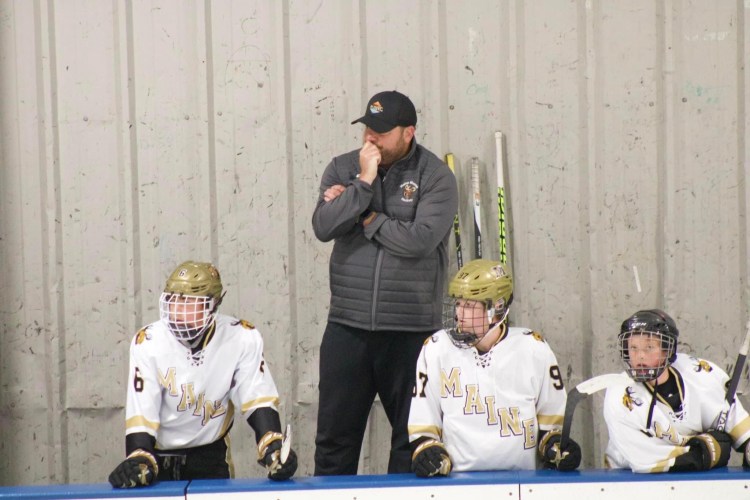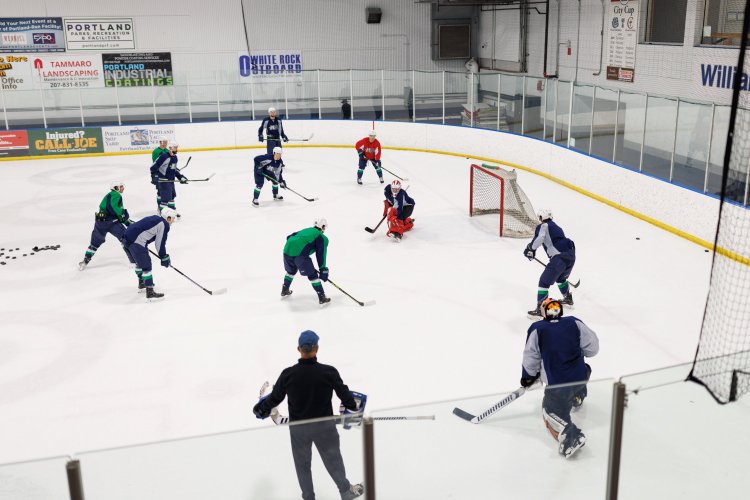
Fans watch a boys varsity ice hockey game Tuesday between Camden Hills and Messalonskee at Kents Hill School’s Bonnefond Ice Arena in Readfield. Youth and high school hockey are losing footing in Maine as rinks close, teams consolidate, and costs rise. “The level of hockey has dropped since I started coaching, that’s for sure,” says longtime coach Norm Gagne. Joe Phelan/Kennebec Journal
Maine’s grasp on its title as one of America’s hockey strongholds is slipping. The state’s ice rinks are closing, high school teams are consolidating, and player counts are falling.
The state has lost nearly 900 registered youth players in the last 20 years. Of the state’s roughly 50 boys and girls high school hockey teams, less than half operate as a single school. Several rinks across the state have closed their doors.
As the cost of everything from operating an ice rink to buying a new stick continues to rise, Maine youth and high school ice hockey is in a slowly increasing tailspin. Many hockey leaders aren’t sure if they can reverse the trend.
‘WATERED DOWN’
Maine has lost many youth hockey players over the last 20 years, according to data from USA Hockey, the country’s ice hockey governing body.
Only about 4,800 Maine hockey players ages 19 and younger signed up to play in the 2022-23 season, the lowest number in two decades outside of the years hampered by COVID-19 precautions.
Twenty years prior, in the 2003-04 season, Maine had more than 5,700 youth players registered — nearly 20% more than today.
Norm Gagne, one of the winningest boys hockey coaches of all time nationally, coached teams in Gardiner, Waterville, Scarborough and elsewhere in Maine over five decades.
He said Maine youth hockey now reminds him of “dump and chase,” a strategy in hockey to create scoring opportunities by flinging the puck down the ice into the offensive zone for forwards to chase down.
Player counts have shrank. Rinks have closed. The cost of playing has gone up. Players and parents have been driven from high school to club teams for a higher quality of play.
All of this, he says, drives down opportunities and the quality of play for Maine’s high school skaters while they and their coaches try making up lost ground: Dump and chase.


Edward Little boys varsity hockey head coach Norm Gagne looks out onto the ice during a game Dec. 16, 2023, against Falmouth High School at Norway Savings Bank Arena in Auburn. Through his long career, Gagne has seen the number of kids playing hockey diminish. “I had 50 kids turn out for my first tryout as a coach in Waterville,” he says. “Now it’s a co-op with two other schools.” Russ Dillingham/Sun Journal file
“I had 50 kids turn out for my first tryout as a coach in Waterville. Now it’s a co-op with two other schools,” Gagne said. “A lot of kids started leaving to better programs and it watered down hockey in the state is what it did. The level of hockey has dropped since I started coaching, that’s for sure.”
Nearly two-thirds of Maine’s high school hockey teams consist of multiple schools. Former high school hockey powerhouses and rivals, like Waterville, Gardiner and Winslow, now pool players to field co-op teams.
There are fewer overall high school hockey teams in Maine than ever, said Michael Bisson, assistant executive director of the Maine Principals’ Association.
“A lot of teams that had programs have now formed co-ops and brought in kids from schools that never offered hockey,” Bisson said. “We have less kids playing, but we have more schools with kids playing.”
The void left by high school hockey is being filled by lucrative club programs that can provide specialized coaching and practices at a significant premium.
‘IT’S NOT CHEAP … BUT IT’S WORTH IT’
The shrinking number of high school hockey teams simultaneously fuels and is fueled by club hockey teams, sometimes called travel hockey teams for the out-of-state tournaments they travel to.
Club teams can charge several thousand dollars in registration fees each season, unlike high school and in-house hockey teams, adding another cost for families looking to play.
Becky Vail, who travels from Topsham with her 12-year-old son to play for the Maine Moose club team in Gardiner, said her son isn’t sure if he’d rather play travel or high school hockey in the coming years.
Club hockey teams have less restrictions on how many games and practices they’re allowed to play, in turn providing a better quality of hockey and more intensive coaching while playing more games than high school teams.
“It’s about $1,500 in registration fees. It’s not cheap,” Vail said. “Plus travel to tournaments and games, it’s a lot, but it’s worth it.”


Greg Dumais, the new Hebron Academy girls hockey coach, has coached for the Maine Moose and Maine Gladiators youth hockey organizations. As director of rink operations for Hebron’s Robinson Arena, Dumais wants to use the space to promote youth hockey in Maine. He says, “I’m going to try to build a youth hockey league based out of Hebron in the future.” Submitted photo
Club teams are required to play between 10 and 24 games against other Maine teams but can play as many games as they want otherwise, opening the door for teams to compete in tournaments in Canada and across the U.S.
Vail and her family had recently returned from Niagara Falls, where their son had finished a tournament playing for the Moose.
High school hockey is free for most students who sign up, though some teams charge registration fees. Teams can play a maximum of 18 league games and five “exhibition” games a season under rules from the Maine Principals’ Association.
The MPA says the rules keep smaller schools on a level playing field as those with large athletics programs, especially as their place in Maine’s hockey ecosystem is taken up by club teams.
“Years ago, there was a path to playing hockey were you played in house leagues, then you played high school,” Bisson said. “Now there’s so many competing groups pulling kids in different directions. I think there’s probably a lot of reasons why, and I don’t know that you could pinpoint one.”
Some coaches and parents, however, say this dilutes the quality of play in high school athletics and gives parents and players more reason to play for club teams.
But while more ice time and better coaching comes at a price, so does new gear.
The price of hockey gear has risen sharply over the last 30 years. Wooden sticks that cost less than $30 in the early 2000s have been supplanted by carbon fiber sticks that can cost over $200.
While many parents and players use second-hand gear from online apps and local stores to save money, between shin guards, elbow pads, a helmet and more, a full set of new gear can cost well over $1,000.
“The expense that goes with it just continues to rise. Gear’s not cheap,” Bisson said. “That’s something a lot of other sports don’t have.”
Some, like Hebron Academy girls hockey coach Greg Dumais, attribute the fall of youth players in part to cultural shifts in school administrations, namely prep schools.
“We’ve kind of, not lost our way, but the priorities have shifted over the years. And they drifted a little bit away from promoting hockey,” Dumais said in September. “We’ve got a new administration here that’s focusing more on athletics to drive kids in.”
Still, it’s difficult for skaters of all ages to play ice hockey when rinks across the state are struggling to stay open, he said.
FEWER TEAMS STANDING
Several ice rinks across Maine have closed for good over the last 10 years, simultaneously battered and fueled by the same trends impacting the players they cater to: Fewer teams, less demand and higher costs.
Saco’s OA Sports Center and Winslow’s Sukee Arena both closed in 2016, leaving several high school and club teams without home rinks.
Sukee closed because it was too expensive to continue operating. OA shut down when the minor-professional Portland Pirates moved to Springfield, Massachusetts, and took their youth travel teams with them.
Both closures left several youth teams scrambling for new home ice. High school and travel teams that once played out of Sukee are now spread between rinks in Hallowell and at Colby College in Waterville. Portland-area teams have merged to share increasingly sparse time at the William B. Troubh Ice Arena, now the only public rink in city limits.


A group of Maine Mariners work on a shooting drill Oct. 10 at William B. Troubh Ice Arena in Portland, the only rink in Maine’s largest city. Brianna Soukup/Portland Press Herald file
Many of Maine’s remaining rinks are owned by colleges like Bowdoin, Bates and Colby. All three have their own college programs whose games and practices take priority over the local high school teams the colleges lend their rinks to.
Dumais is trying to buck that trend. After becoming the director of rink operations at Hebron Academy’s Robinson Arena in September, he said he intends to make ice time available to outside players and teams rather than just the school’s own programs.
“I think there’s an opportunity, because of the shortage of the ice that we’re seeing in central Maine, to open it up and bring people back on campus,” Dumais said. “We want to bring in potentially a future youth hockey league. I’m going to try to build a youth hockey league based out of Hebron in the future.”
As rinks close, it’s not uncommon for players on high school, travel and recreational teams alike now to routinely drive an hour or more round trip five or six times a week for practices, games and clinics while teams of 20 years ago could drive 15 minutes.
As more teams battle for less ice, the shrinking number of rinks has partly fueled the double-digit declines in players across both boys and girls ice hockey.
With fewer rinks, players and teams alike, some question if Maine hockey will ever be what it was in the 1990s and early 2000s.
“I don’t know that there’s a plan to build hockey back up,” Bisson said. “We’re relying on the schools. I think it needs to be grassroots.”
Send questions/comments to the editors.



Join the Conversation
We believe it’s important to offer commenting on certain stories as a benefit to our readers. At its best, our comments sections can be a productive platform for readers to engage with our journalism, offer thoughts on coverage and issues, and drive conversation in a respectful, solutions-based way. It’s a form of open discourse that can be useful to our community, public officials, journalists and others. Read more...
We do not enable comments on everything — exceptions include most crime stories, and coverage involving personal tragedy or sensitive issues that invite personal attacks instead of thoughtful discussion.
For those stories that we do enable discussion, our system may hold up comments pending the approval of a moderator for several reasons, including possible violation of our guidelines. As the Maine Trust’s digital team reviews these comments, we ask for patience.
Comments are managed by our staff during regular business hours Monday through Friday and limited hours on Saturday and Sunday. Comments held for moderation outside of those hours may take longer to approve.
By joining the conversation, you are agreeing to our commenting policy and terms of use. More information is found on our FAQs.
You can modify your screen name here.
Show less
Join the Conversation
Please sign into your Press Herald account to participate in conversations below. If you do not have an account, you can register or subscribe. Questions? Please see our FAQs.